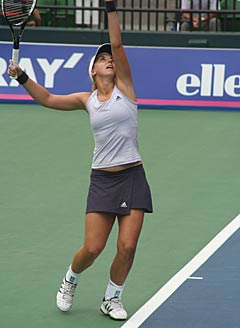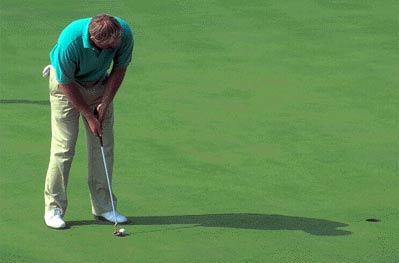|
TennisOne Lessons Commitment Issues Marcus Paul Cootsona A Server Named Maria Maria Sharapova has a big problem. It's June 30, 2011, Centrex Court, Wimbledon. Battling Sabine Lisicki for a spot in the finals, she can't get her serve in. Really can't get it in. Things are bad — Shaquille-from-the-line bad. Moon launch toss. Speed bump swing. Roller coaster shoulder dips. A gracefully conflicted windmill taking a stage bow. She double faults 13 times in 66 serve points, gets in just 48% of her first serves and 21 of 34 second serves. But here's the serve kicker — The big problem doesn't stop her. She beats Lisicki 6-4, 6-3 and grits her way into the finals.
And it wasn't just at SW19. Maria scuppered a fleet of first and second serves in a worldwide armada of matches in 2010 and 2011, but still often won and steered a mostly steady course back up the WTA rankings. Double-faulting 13 times in the Wimbledon semi isn't a recommended method for match success (Sharapova also lost plenty of matches at the hand of her serve too), but Maria's way of dealing with her serve problems is. So, what's Maria doing right when things are going wrong, and how can we do it too? And would it have helped Shaq? Statistically, the serve is the most important stroke in match tennis, but as Maria proved, even terrible numbers don't necessarily doom a player and their chances. And good numbers don't always spell the "w." In losing that same semi, Lisicki made only four double faults and served harder too. Clearly, there must be something else more important for winning matches than even the most important stroke. There is, and Maria is the wealthy, famous, living proof. It's not a stroke. It's an attitude: Commitment. Specifically, commitment to each stroke you hit, regardless of the situation, the opponent or the score. This is what Maria's doing right. Maria Sharapova is a great champion, a tenacious competitor and not a bad dresser, either. She rarely lets another player into her game physically or lets her own difficulties affect her mentally. She stays committed to her game when things are going well and when things are not going so well. This is how she wins with a faltering, spazzy serve. Her wayward serve is a classic recreational stroke issue, but her solution is pure professional. Recs typically flounder during stroke storms. But the pros can't afford to let a one-shot tsunami capsize their game. Except for the occasional plane catching, sandbagging, or mood swings, they stay committed to their game and their strokes. How? Rigorous practice, sports shrinks, and a lot of staff to pay. It's simply too expensive to space out. Watch a pro match and take notice, not just of the tans, the teeth, and the amount of employees in the player's box, but of how the pros commit to their shots. Even when a pro is going to hit the most ill-advised shot of the Open Era or a routine open court winner blast, they hit every shot with a focus, purpose, conviction, and a fresh overwrap. Watch a recreational match, and see how often a player waffles on a shot and eats the point.
The Road Not Taken The Oxford American Dictionary defines commitment as: “Dedication. Application.” And, “An engagement or obligation that restricts freedom of action.” So commitment is positive, but it's also negative. Like Azarenka's Indian Wells outfit. Positive because you go through with what you started. Negative because you don't go through with something else. But even this negative, restrictive side is positive for tennis matches. Restricting freedom of action on the court (by cutting out too many on-court decisions and revisions) is a good thing. And for a good reason. Tennis is a reactive game. We fully control the serve, but as we've seen with a certain player, that doesn't always help. When you're in the flow of a point, there's not much time to run options and none at all to re-work your strokes. You need to know what you're going to do and then do it with intention and conviction. Any doubt that distracts you from this quick, dynamic reaction hurts your ability to make good strokes and points. Everyone lacks something. You may crack groundies, but crack up at the net. You may hit all your shots like a general, but fumble like a new recruit at set point. You may hit heartily against lesser players, but wimp up against the bigs. But as my jazz band director in high school used to say, "Make your mistakes loud." Then you know what to work on. Commit to your shots; your winners and your errors. And if something's goes toxic, seal it off and keep the damage contained. Compartment Head In the last two years, Sharapova saved more matches than you can shake a sponsored stick at by committing fully to her game as it was that day. She cordoned off the problem stroke (yes, her serve) on each point and after each point and didn't let it spill over to her other strokes in that point, or to other points. She might have wanted to tinker with her motion or her toss during the match — watching at home, I know I did — but this would only have made things worse.
Not only would her serve not have been working, not only would the correction probably not have helped, but the distraction caused by the correction would have thrown off her other strokes as well. Instead, she committed to playing with the flawed stroke she had and won the necessary points in other ways. The practice court is truly the only place for a wholesale correction like the one Maria needed. Without the analytic shut down of the fight-or-flight match brain, you can spend time and repetitions making a smart, lasting fix. Of course, all good match players adjust during a match (Nadal and his shorts, for instance), but adjusting is different than revising. As my golf pro friend, Zach, once sagely counseled, "No swing thoughts on the golf course." (Or the tennis court for that matter. Especially if they're golf swing thoughts.) Contrast this with tennis as played by the 99%. In this larger world of players, egos often stay wounded from that mishit shot two points ago. Worse still, players want lesson perfection on the court and derail the good stuff they are doing lamenting every error. The pros know that the only fact that really matters is: Did the shot go in? And then, what's the opponent doing with the ball now? And only later, how many points was I defending? Regret costs you. Contentment rewards you. The only important shot in tennis is the one you're about to hit. Deniable Plausibility Committing to commitment takes commitment. Wimbledon semis or the challenge court at the club, keep your commitment to commitment by praising yourself for all your good shots and ignoring the bad ones. The great golfer, Jack Nicklaus, once said, "I've never missed a 3-footer." Of course that's not literally true, Jack missed 3-foot putts. Even the greatest golfer of all time can't jar everything. He also said when asked to describe a short putt that didn't drop, "I made that one, it just didn't go in." So what did he mean?
What Jack meant in both cases was this — if you hit it right, you hit it right and you'd hit it the same way again the next time and all the times after that. In tennis too, once you have your stroke and your method, you don't doubt it. You commit to it and do it. And ignore the outcome when it isn't good, and move on to the next point. Jack wasn't being delusional. He was being a champion. Champions win by believing they're champions, regardless of how they're hitting that day. Adopting Jack’s short-term, amnesiac view of mistakes helps open your mind to stroke commitment. If you let your mind dwell on mistakes that have already happened, they will take over your current shots. Forget the bad shots. Just get ready to hit the next one. A short-term, narrow view into the future helps too. Don’t obsess over the mistakes you may make, either, okay? Assume success and deny the rest. This doesn't mean, by the way, that simply hitting shots with conviction or willfully blocking out errors will make flawed strokes technically better. That happens through practice, dedication to improvement and a cash windfall. You can bet that Jack practiced a lot of those 3-footers he "never missed" and Maria spent 1016 hours trying to tame her disobedient serve. Just not during a competition.
Practicing Commitment Maria Sharapova is the poster girl for commitment, fortitude, success and nike, Canon, and Cole Haan. It's what you get when you have to prove yourself on court at a young age, in a new country, and a tough environment, with uncertain serve instruction. However, Maria's way is not the only way to find mental fortitude. It's possible to gain confidence simply through stroke competence and the use of on-court compartmentalization. Emigration is optional. But like Maria, we need to face the facts and go into every match and compete with the game we have. The first step then is to figure out what that game is.
Check For Leaks — Which of your strokes distracts you from your game? Take an inventory to find which ones fill you with something less than full confidence. Make these better and boost your level of competence. Once you do the analysis, it's time for practice Trouble Ball — Somewhat like the golf drill, "worst ball." Select your weakest stroke and during a practice rally, try to respond to every ball with this shot. For instance, if you don't like your backhand volley, take every deep ball, mid-court ball and volley from the backhand side and try to volley it. Russian Around — There is some good that can come from Maria's troubles: this exercise for one. Hit only one serve per practice point and make it a weak second serve. As you play it out, make adjustments to the rest of your game knowing that your serve will not carry the day. No need to toss too high, lose your timing or drop your head, though.
After all or some of that, it's time to court test it. Play a practice match where you score, but where you don't worry about the score (a good exercise on its own) and hit every shot like you mean it. Natural or Nurtural? It's been said that you can't coach height. Or innate talent. Or most of the players on tour. But you can coach yourself on commitment. Starting today. Be Maria. Embrace your inner Sharapova. Complete and accelerate each stroke and use your lower body. Stay within your game and re-focus after every point. Conference with your fist pump. Hit each shot and live with the consequences. If the ball goes long, stay in your game. If you hit absolutely the wrong shot, stay in your game. If you have to switch racquet endorsements for financial or philosophical reasons, stay in your game. Have faith in what you're doing no matter how it's going or if your opponent shrieks even shriller than you. Always hit like you mean it and carry yourself like a winner. Play each match with resoluteness, resolve and fearlessness. Oh, and work on your serve. Practice Often. Play Well. Have Fun. Your comments are welcome. Let us know what you think about Marcus Paul Cootsona's article by emailing us here at TennisOne .
Marcus Paul Cootsona is a teaching professional and author of Occam's Racquet – 12 Simple Steps To Smarter Tennis. Contact him at: marcuscootsona.com. |


 Marcus Paul Cootsona
Marcus Paul Cootsona